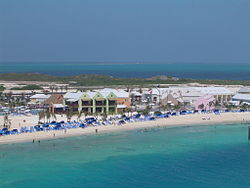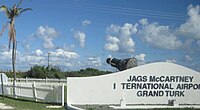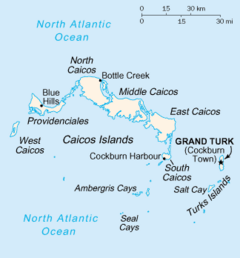Grand Turk Island: Difference between revisions
Created page with '{{Infobox island |name=Grand Turk |county=Turks and Caicos Islands |group=Turks Islands |picture=Grand Turk beach.JPG |picture caption=Southwestern beach at Grand Turk, by the cr…' |
No edit summary |
||
| (One intermediate revision by the same user not shown) | |||
| Line 13: | Line 13: | ||
|population=3,720 | |population=3,720 | ||
}} | }} | ||
'''Grand Turk Island''' is an island in [[Turks Islands]], the smaller of the two archipelagos that make up the territory of the [[Turks and Caicos Islands]]. It is the largest island in the Turks Islands, covering | '''Grand Turk Island''' is an island in [[Turks Islands]], the smaller of the two archipelagos that make up the territory of the [[Turks and Caicos Islands]]. It is the largest island in the Turks Islands, covering seven square miles, though it is dwarfed by the neighbouring Caisos Islands. | ||
Grand Turk contains the territory's capital, [[Cockburn Town]] and the JAGS McCartney International Airport. The island is the administrative, historic, cultural and financial | Grand Turk contains the territory's capital, [[Cockburn Town]] and the JAGS McCartney International Airport. The island is the administrative, historic, cultural and financial centre of the territory, and has the second largest population of the islands at approximately 3,720 people. | ||
[[File:Grand Turk Friendship 7 replica. | [[File:Grand Turk Friendship 7 replica.jpg|thumb|left|200px|Replica of the ''Friendship 7'']] | ||
Grand Turk gained international attention in 1962 when John Glenn's ''Friendship 7'' spacecraft landed in the vicinity of Grand Turk Island off the southeast shoreline, the command module of the Mercury-Atlas 6. A replica of the ''Friendship 7'' is on display in Grand Turk at the entrance to the Grand Turk Island airport.<ref>[http://www.visitprovidenciales.com/about/history.aspx Turks and Caicos History]</ref> | Grand Turk gained international attention in 1962 when John Glenn's ''Friendship 7'' spacecraft landed in the vicinity of Grand Turk Island off the southeast shoreline, the command module of the Mercury-Atlas 6. A replica of the ''Friendship 7'' is on display in Grand Turk at the entrance to the Grand Turk Island airport.<ref>[http://www.visitprovidenciales.com/about/history.aspx Turks and Caicos History]</ref> | ||
| Line 23: | Line 23: | ||
The island's name and that of the group come from a species of cactus on the island, the Turk's Cap Cactus (''Melocactus'') intortus, which has a distinctive cap, reminiscent of a Moorish fez. | The island's name and that of the group come from a species of cactus on the island, the Turk's Cap Cactus (''Melocactus'') intortus, which has a distinctive cap, reminiscent of a Moorish fez. | ||
Grand Turk is possibly the landfall island of Christopher Columbus during his discovery of the New World in 1492.<ref>Dyson, John. ''Columbus: For Gold, God, and Glory'', (Toronto, Ontario, Canada: Madison Press Books, 1991), p. 164-165. ISBN 0-340-48794-1</ref><ref>{{cite | Grand Turk is possibly the landfall island of Christopher Columbus during his discovery of the New World in 1492.<ref>Dyson, John. ''Columbus: For Gold, God, and Glory'', (Toronto, Ontario, Canada: Madison Press Books, 1991), p. 164-165. ISBN 0-340-48794-1</ref><ref>{{cite book |author=Power, Robert H. |year=1983 |title=The Discovery of Columbus's Island Passage to Cuba, October 12–27, 1492 |journal=Terrae Incognitae |volume=15 |pages=151–172}}</ref> San Salvador Island or Samana Cay in the Bahamas is traditionally considered the site of Columbus' first landfall, but some believe that studies of Columbus' journals show that his descriptions of Guanahani much more closely fit Grand Turk than they do other candidates. | ||
In 1966 Grand Turk became the centre of atospheric experiments and saw the launch of five sounding rockets.[http://www.astronautix.com/sites/grasland.htm] | In 1966 Grand Turk became the centre of atospheric experiments and saw the launch of five sounding rockets.<ref>[http://www.astronautix.com/sites/grasland.htm Astronautix]</ref> | ||
==References== | ==References== | ||
Latest revision as of 21:50, 21 May 2018
| Grand Turk | |
 Southwestern beach at Grand Turk, by the cruise ship dock | |
|---|---|
| Location | |
| Location: | 21°28’20"N, 71°8’20"W |
| Area: | 6.9 square miles |
| Data | |
| Population: | 3,720 |
Grand Turk Island is an island in Turks Islands, the smaller of the two archipelagos that make up the territory of the Turks and Caicos Islands. It is the largest island in the Turks Islands, covering seven square miles, though it is dwarfed by the neighbouring Caisos Islands.
Grand Turk contains the territory's capital, Cockburn Town and the JAGS McCartney International Airport. The island is the administrative, historic, cultural and financial centre of the territory, and has the second largest population of the islands at approximately 3,720 people.

Grand Turk gained international attention in 1962 when John Glenn's Friendship 7 spacecraft landed in the vicinity of Grand Turk Island off the southeast shoreline, the command module of the Mercury-Atlas 6. A replica of the Friendship 7 is on display in Grand Turk at the entrance to the Grand Turk Island airport.[1]
The island's name and that of the group come from a species of cactus on the island, the Turk's Cap Cactus (Melocactus) intortus, which has a distinctive cap, reminiscent of a Moorish fez.
Grand Turk is possibly the landfall island of Christopher Columbus during his discovery of the New World in 1492.[2][3] San Salvador Island or Samana Cay in the Bahamas is traditionally considered the site of Columbus' first landfall, but some believe that studies of Columbus' journals show that his descriptions of Guanahani much more closely fit Grand Turk than they do other candidates.
In 1966 Grand Turk became the centre of atospheric experiments and saw the launch of five sounding rockets.[4]
References
- ↑ Turks and Caicos History
- ↑ Dyson, John. Columbus: For Gold, God, and Glory, (Toronto, Ontario, Canada: Madison Press Books, 1991), p. 164-165. ISBN 0-340-48794-1
- ↑ Power, Robert H. (1983). The Discovery of Columbus's Island Passage to Cuba, October 12–27, 1492. 15. 151–172.
- ↑ Astronautix
